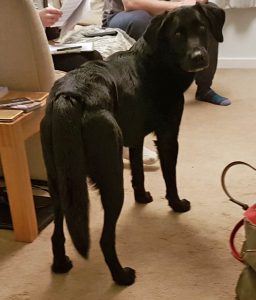I found Dexter friendly, but careful. He tries to please – almost like he’s scared not to.
He is a three-year-old mix of mostly Labrador and Lurcher or Greyhound. They have had him for just three months.
When out of the house fear takes over and then he’s unable to take notice of them.
Unsafe on lead
 Walking by the roads Dexter simply feels too unsafe so he’s on high alert, panting and pulling. Twice a day he pulls desperately to the nearby field where they can let him off lead. Once free, he’s a different dog. He charges about, happy, and will once more listen to them.
Walking by the roads Dexter simply feels too unsafe so he’s on high alert, panting and pulling. Twice a day he pulls desperately to the nearby field where they can let him off lead. Once free, he’s a different dog. He charges about, happy, and will once more listen to them.
Dexter feels so unsafe only when he’s on lead. If he sees another dog, even at some distance, he starts to bark. The frantic barking then changes into a high-pitched cry. He then will jump up on them, almost hugging them, scared and appeasing at the same time, like expecting something very bad to happen.
I would hazard a guess that in his previous life barking at other dogs had resulted in some kind of punishment. It could have been an electric collar, compressed air or some other horrid gadget – or maybe human anger.
‘Controlling’ barking is possible if someone is sufficiently cruel (not his new owners, of course, who chose me because the saw I use only kind and positive methods ).
The barking itself, however, isn’t the problem. It’s fear. How can punishing fear not make the fear worse?
Trust in the person holding the leash
What the gentleman in particular now does is to ‘control’ him, hold him tight, and make warning noises. The lady may be more encouraging, but they both continue walking towards the other dog, holding him tight. No escape. No wonder he feels so unsafe when on lead.
There is no place for punishment or scolding with the nervous, careful Dexter (or any dog, in my opinion).
Off lead he has met several dogs in different environments and situations and he is mostly fine.
They will get nowhere with either his lead-pulling or his barking at other dogs when on lead while he feels so unsafe.
Progress means that he must totally trust the person holding the lead. They can do their best with corrections and ‘No’, but this won’t build trust and can only make his underlying unsafe emotions even worse.
Starting at the beginning
 The first step is to work on loose lead walking and to help him feel safer just immediately outside the house.
The first step is to work on loose lead walking and to help him feel safer just immediately outside the house.
They can just stand about doing nothing much and drop food. Next they can wander about all over the place but going nowhere in particular, mooching, using encouragement and rewards. Slowly Dexter should begin to relax and feel less unsafe. Leaving the house no longer just a mad dash to the fields.
While they work on this, so that they don’t undo their good work at building up his confidence and trust meanwhile, they will take him to the open, off-lead places by car.
They will help him to associate approaching dogs only with things he loves like food and his ball, no scolding or force, whilst keeping him at what he considers to be a ‘safe’ distance.
As they build up his trust, this distance will get smaller.
Only the person at the other end of the lead has the power to make things change. It will take time and patience.



